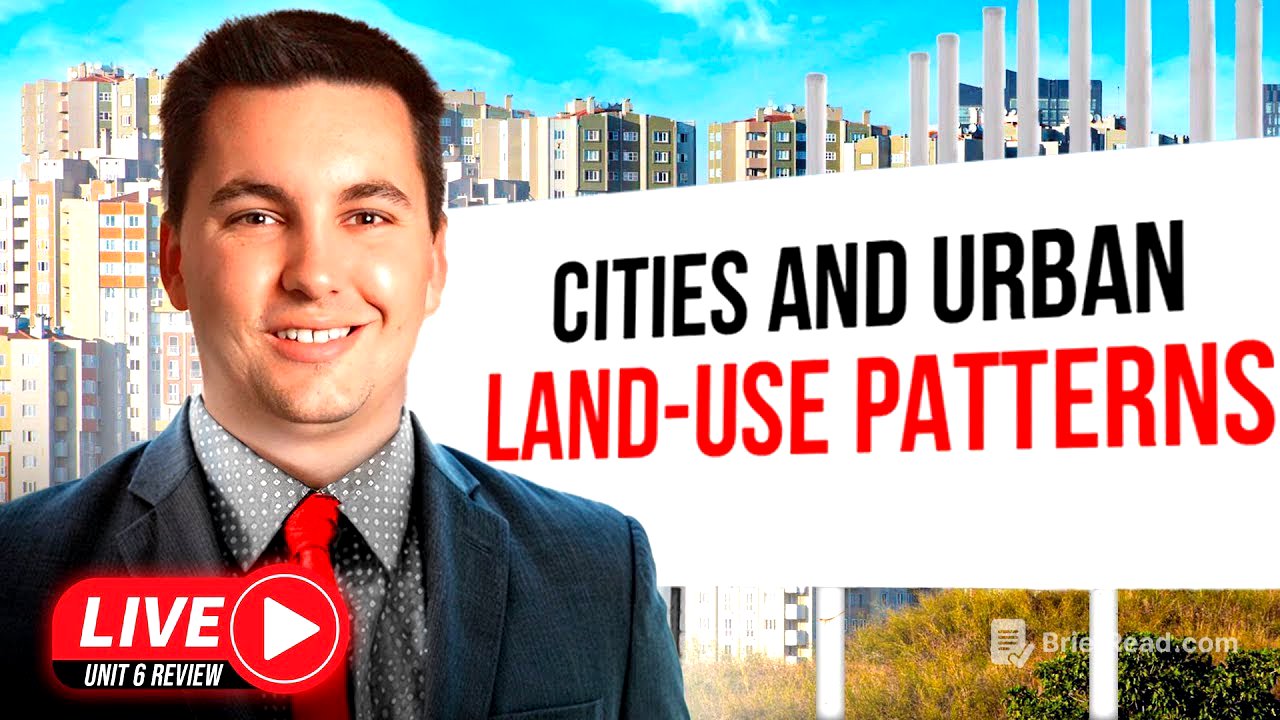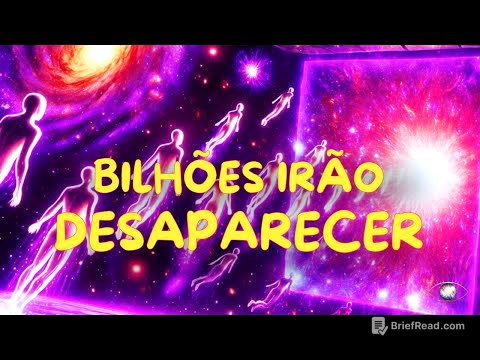TLDR;
This video is a comprehensive review of AP Human Geography Unit 6, focusing on cities and urban land use. It covers key concepts such as urban hearths, transportation infrastructure, mega-cities, urban decentralization, and urban sprawl. The review also examines urban models, including the Concentric Zone, Hoyt Sector, Multiple Nuclei, Galactic, Latin American, Sub-Saharan African, and Southeast Asian models. Additionally, it discusses density gradients, infrastructure, urban sustainability, zoning, mixed land use, walkable cities, transit-oriented development, new urbanism, green belts, infilling, slow-growth cities, brownfields, and various forms of segregation and injustice. The session concludes with a discussion of qualitative and quantitative data in urban planning.
- Focus on site and situation factors influencing urban areas.
- Understand the impact of transportation and infrastructure on urbanization.
- Differentiate between mega-cities and meta-cities.
- Recognize the characteristics and implications of primate cities and rank-size rule.
- Understand the concepts of threshold and range in central place theory.
- Familiarize yourself with various urban models and their applicability in different regions.
- Understand the concepts of urban sustainability, zoning, and mixed land use.
- Recognize the causes and consequences of gentrification, redlining, and environmental injustice.
Introduction [0:00]
The video introduces a recap of Unit 6, which focuses on cities and urban land use. It mentions upcoming live reviews for Unit 7 and additional sessions on Monday night that will focus on FRQs and multiple-choice questions. The session aims to provide a comprehensive overview of the key concepts within Unit 6.
Urban Hearths and Transportation [1:10]
The discussion begins with urban hearths, emphasizing the importance of site and situation in the development of urban areas. Site refers to absolute location factors, while situation involves relative connections to other places. Many origin points are located near trade routes, rivers, or oceans, with access to arable land. Transportation infrastructure significantly influences urbanization, affecting how people live, opportunities, and settlement patterns. Changes in transportation and communication technologies drive the evolution of cities.
Mega Cities, Meta Cities and Urban Decentralization [3:06]
The video defines mega-cities as those with over 10 million residents and meta-cities as those with over 20 million. Many of these cities are located in periphery or semi-periphery countries, reflecting high population growth rates in less economically developed areas, aligning with stage two of the demographic transition model. Urban decentralization is the movement of population and resources away from core urban areas to peripheral regions, leading to the growth of suburbs, boomburbs, and exurbs.
Urban Sprawl and Land Use [6:18]
Urban sprawl is defined as unrestricted growth and expansion, often replacing arable land and negatively impacting the environment. Tokyo is presented as an example of a city with significant urban sprawl. Suburbanization and sprawl contribute to urban decentralization, shifting resources and power away from urban cores. Boomburbs are rapidly growing suburban areas with unique identities, exurbs are settlements outside suburban areas with lower population densities, and edge cities are self-sufficient areas with businesses, shopping centers, and access to highways.
World Cities and Linkages [9:30]
World cities are major cities with global influence in economy and culture, often hosting stock exchanges and embassies. They sit atop the urban hierarchy and diffuse culture and ideas globally. Linkages are connections between different places, industries, and sectors, facilitated by quality infrastructure and communication networks. These connections are also relevant to break-of-bulk points, where goods transfer between transportation modes.
Primate City and Rank Size Rule [11:37]
A primate city is significantly larger than other cities in a country, concentrating opportunities and resources, which can lead to economic inequalities. Examples include South Korea and Mexico City. The rank-size rule describes a settlement hierarchy where the second-largest city is half the size of the largest, the third is one-third, and so on, indicating more even economic development. Canada and Brazil are examples of countries following the rank-size rule.
Interdependence and Gravity Model [15:15]
Interdependence is the mutual reliance between different groups and organizations, highlighting that countries do not exist in isolation. The gravity model, connected to Ravenstein's laws of migration, explains the interaction between places based on their size and distance. Larger cities with more opportunities exert a greater pull, attracting people even from closer, smaller places.
Central Place Theory [18:12]
The central place theory includes the concepts of threshold and range. Threshold is the minimum number of people required to support a good or service, while range is the distance people are willing to travel for it. The theory explains the spatial distribution of cities and the formation of urban hierarchies, where larger settlements have greater pull. Specialized goods and services have longer ranges and higher thresholds, often located in larger urban areas near transportation hubs.
Urban Models [23:52]
The video discusses several urban models, starting with the Concentric Zone Model, which features decreasing density as one moves further from the central business district (CBD). Lower-income residents typically reside in the zone of transition. The Hoyt Sector Model emphasizes the role of transportation, with industries and businesses locating near transportation routes. The Multiple Nuclei Model describes cities with multiple centers or nodes that attract or repel different populations based on activities in those areas. The Galactic Model factors in edge cities and beltways, reflecting modern transportation and infrastructure.
Latin American, Sub-Saharan African, and Southeast Asian City Models [31:16]
The Latin American city model reflects colonial influences, with a central plaza, market, and spine connecting to a port. Wealthier residents live along the spine, while disamenity zones house lower-income populations. The Sub-Saharan African city model shows the impact of European colonization with a colonial CBD, traditional CBD, and ethnic neighborhoods divided by roads. The Southeast Asian city model features a port zone instead of a traditional CBD, reflecting its role as a trading post during the colonial era.
Density Gradient [38:42]
The density gradient describes the gradual change in population density from the urban core to the periphery. High-density areas rely on public transportation and offer social and economic opportunities but can suffer from poor urban planning. Medium-density areas feature a mix of housing types and proximity to services, while low-density areas have single-family homes, greater reliance on personal vehicles, and less access to public transportation.
Infrastructure and Urban Sustainability [44:25]
Infrastructure, including roads, utilities, and internet cables, enables cities to function. Its quality directly impacts economic and social development. Urban sustainability promotes sustainable economic and social growth, focusing on environmental, economic, and social equality. Zoning regulates land use to promote sustainability, while fragmentation of government can create problems for cities.
Mixed Land Use and Walkable Cities [50:01]
Mixed land use involves buildings with different activities in the same structure, common in medium to high-density areas. Walkable cities promote walking by locating amenities in close proximity, reducing congestion. Transit-oriented development strategically places public transit stations to reduce car use. New urbanism focuses on small-scale neighborhood design, while smart growth policies manage urban development and resource use across larger areas.
Green Belts, Infilling, and Slow Growth Cities [53:15]
Green belts are areas of undeveloped land for recreation and conservation outside urban areas. Infilling involves building on unused or underdeveloped land to increase density and prevent urban sprawl. Slow-growth cities limit growth to promote sustainability, often using growth boundaries to prevent building outside designated areas. Smart cities use technology and data to reduce inefficiencies.
Brownfields and Segregation [57:14]
Brownfields are abandoned properties with contamination that require cleanup before redevelopment. De facto segregation is the separation of people along racial, economic, or ethnic lines, not enforced by laws but resulting from historical practices like redlining and blockbusting. Gentrification occurs when wealthier people move into an area, increasing property values and displacing lower-income residents.
Redlining, Blockbusting, and Environmental Injustice [1:00:04]
Redlining is a discriminatory practice where banks refuse loans to people in certain neighborhoods, often minority areas. Blockbusting involves real estate agents using misinformation to motivate white homeowners to sell at lower prices, contributing to white flight. Environmental injustice refers to the disproportionate exposure of marginalized communities to environmental hazards.
Squatter Settlements and Inclusionary Zoning [1:03:59]
Squatter settlements are areas where people build homes on land they do not own. Inclusionary zoning involves local policies that incentivize developers to create affordable housing, promoting mixed-income communities. A city's ecological footprint is the amount of land and resources used to support its population.
Qualitative and Quantitative Data [1:06:07]
Qualitative data includes observations and descriptions, while quantitative data consists of objective facts and measurable data. Cities use both types of data to inform public funding, policies, and urban planning decisions.









